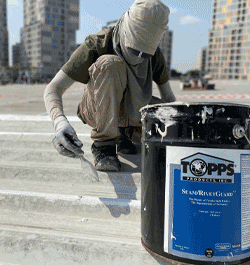UP TO THE MINUTE
Common commercial roof coating mistakes

By Henry Staggs, roofing expert, consultant and expert witness.
Not all roof coatings are created equal. Don't make these common mistakes when assessing the quality of a roof coatings material.
Not all coatings are made the same
Some time ago, while running a roofing consulting company, I was having lunch with a roofer considering adding to our bidders list. While discussing roof coatings, he said something that stuck in my head to this day. "As long as it is white, who cares!" I care for one; secondly, the owner paying us also cares. The fact is that roof coatings, like any other manufactured product, are not all made the same. Some have more fillers, while others have fewer fillers, for example. There are some low quality materials out there and some high quality ones out there. The lower the grade of material, the shorter its service life will be.
"As long as it is white, who cares!" is not the most excellent way to assess the quality of a roof coating material.
Poor excuse for roof preparation
When a roof is improperly washed and prepped before applying coating material. The project is doomed from the start. The simple fact is that when the roof is not prepared correctly, there will be dirt and other contaminants on the roof. Applying the coating over contaminants and debris compromises the coating's adhesion. The result could be blistering, leading to cracked blisters and potential water intrusion. Not properly preparing the roof is a surefire way to ensure a short service life with lots of costly repairs.
These are the most essential things everyone should be doing before installing a liquid-applied roof system:
- Power wash the roof surface using a pressure washer with about 3500 psi.
- If needed, use detergents to remove oils and other stubborn contaminants.
- Seal up any penetrations and transitions, preferably with reinforcement
- Make any repairs to the membrane, such as repair blisters or splits.
- Get all the debris off the roof.
- Check the drains and prep the drain area.
Keep the roof clean
Once the roof is prepared, the roof needs to be kept clean. Ensure the crew wears the proper clothing and does not drag new dirt and debris onto the roof. Keep their shoes, boots, tools and equipment clean outside the newly applied coatings. Debris is debris; how it gets up on the roof is irrelevant. Any dirt, oil, debris or even sweat from a crew member's forehead can compromise the adhesion of the coating materials, leading to blistering, split blisters and potential water intrusion.
No reinforcement
Coatings are excellent when applied correctly. Part of doing the job right means using polyester reinforcing fabric in more vulnerable areas. Any place there is evidence of standing water, in the drains, at a transition, or repairing the existing roof membrane should be reinforced. Some liquid-applied roof systems will call for a fully reinforced system. The fact is that while the coating is excellent, they are water resistant and not waterproof (with silicone being the exception). That means that eventually, any water stands in one spot for too long. It will seep through the coating and damage the coating. The coating can become loose and, in the proper condition, be blown off the roof. They are exposing the preexisting roof membrane.
Apply it too thin
Coatings are measured in mils, typically in the 20 mil or higher range. The thicker the coating is, the longer it will provide good service. Acrylic coatings, unlike silicone coatings, do break down over time. The surface will become powdery and, over the year, washed off the roof. The standard rule is that acrylic roof coating can lose one to three millimeters yearly. That means that 26 mils in one year could be 23 mils, and then a year later, 20 mils. It is easy to see why it is always recommended that any acrylic roof project should be revisited every three to five years. The roofers should measure the existing coating (using a specialty tool). Wash the roof and apply more coating to bring the millage back to the desired amount.
Silicone, on the other hand, does not wash away and is waterproof. Often, roofers will apply acrylics to the main field areas. Moreover, use silicone in the drains and around rooftop equipment that produces contaminants, such as grease vents.
Mix matching materials
I am reminded of a job I was overseeing some years ago. The job was to be warranted by one manufacturer. However, when I went up to look over the workmanship, I found they had applied coatings from a different manufacturer. That put a kink in the project because why would one manufacturer warranty another manufacturer's materials? Remember, not all coatings are made the same. Mixing matching materials could add lower grade materials and compromise the entire system and warranties.
Not applying a genuine liquid applied system
Sorry, but applying a top coating is insufficient, even with the proper preparation work. There is a reason we call it top coating. Any roof system, regardless of how it is manufactured. It must have specific components to work. A liquid-applied roof system is a field-manufactured roof system. Before doing anything else, have a professional carefully look over the roof. Please ensure it can be coated, and then draft a comprehensive scope of work for that roof.
- Roof Primer
- Sometimes an epoxy
- Base coat
- Reinforcing fabrics
- The top coat
- When required, granules may be broadcast into the top coat
Not paying that little extra for the NDL warranty
Manufacturers offer what we call labor and materials with no dollar limit warranty. They required a certified contractor to apply the coatings, and most of the time, if only sometimes, they sent out their inspector to look over the workmanship. Paying the little extra fee for this warranty is a good move. If the manufacturer wants to avoid paying for a roof warranty, they will do what they can to ensure the materials are appropriately applied. Moreover, if there is a problem, they will take care of it at no charge.
Learn more about Henry Staggs in his Coffee Shop directory.


















Comments
Leave a Reply
Have an account? Login to leave a comment!
Sign In